Last Updated on November 24, 2025 by Dee
If you’ve ever admired crisp, perfect line work in illustrations, hand lettering, or watercolor sketches, chances are those artists were using Micron pens. These aren’t just any pens—they’re the gold standard for artists who want precision, permanence, and professional results every single time. Download the FREE
After years of teaching art and using Micron pens in my own creative work, I’ve learned what works (and what doesn’t) when it comes to getting the most out of these incredible tools. Whether you’re just discovering Micron pens or looking to level up your technique, this guide covers everything from proper grip to the best paper choices, plus all the supplies you need to create stunning pen and ink artwork.
Ready to transform your line work? Let’s get started.
Wondering How to Use Micron Pens?
Table of Contents

What Makes Micron Pens Special?
Before we dive into techniques, here’s why thousands of artists swear by these pens:
Archival Quality: Micron ink is chemically stable, waterproof, and fade-resistant for up to 100 years. Your artwork won’t yellow, fade, or deteriorate over time.
Precise Line Work: The ultra-fine nibs (ranging from 0.20mm to 0.50mm) give you complete control over line weight and detail.
Waterproof Pigment Ink: Once dry, Micron ink won’t smudge or bleed when you add watercolor, markers, or other wet media on top.
Versatile: Perfect for everything from manga and comics to journaling, calligraphy, architectural drawings, and mixed media art.
Companies like Google and Vans have used Micron pens to design illustrations on their products. Some professional artists have relied on them for over a decade—that’s staying power you can trust.
12 Essential Tips for Using Micron Pens Like a Pro

1. Master Your Grip
Hold your Micron pen firmly but gently, centered between your thumb and forefinger. Think of it like holding a regular pen—but with less pressure. The pen should glide smoothly across the paper, creating crisp, clean lines without you having to press hard.
Pro tip: If you find yourself gripping too tightly or your hand cramping up, pause and shake out your hand. Tension kills precision.
2. Use Shorter Strokes
Long, continuous lines can cause the nib to clog with paper fibers or dried ink. Instead, build your lines with shorter, controlled strokes. This keeps the ink flowing smoothly and extends the life of your nib.
3. Always Let Paint Dry First
If you’re working with watercolor or any wet media, patience is key. Wait until your paint is 100% dry before going over it with your Micron pen. Even a slightly damp surface can clog the nib or cause the ink to bleed.
Similarly, if you’re adding watercolor on top of pen work, let the ink dry completely (about 30-60 seconds) before painting.
4. Test Your Nib Sizes
Before starting your final piece, test your pen sizes on scrap paper. This helps you visualize line weight and see how different sizes work together. I always keep a test strip next to my workspace—it’s saved me from countless mistakes!
5. Replacement Nibs (Sort Of)
Micron pens are technically disposable, but here’s a little secret: you CAN replace a nib if you’re careful. Using craft pliers, gently pull off the old nib and swap it with a spare from another pen of the same size. Not officially recommended, but it works in a pinch.
6. Choose the Right Paper
Paper quality makes or breaks your Micron pen experience. Smooth, high-quality paper designed for pen work is essential. If the surface feels rough and your nib keeps catching, switch papers immediately.
Best papers for Micron pens:
- Bristol board (smooth finish)
- Mixed media paper
- Hot-pressed watercolor paper
- Quality sketchbook paper (not cheap newsprint)
7. Draw at an Angle
Writing at a slight angle (about 60-70 degrees) helps prevent ink buildup in the nib. This simple adjustment keeps your lines consistent and reduces clogging.
8. Build Expressive Line Work
Micron pens are perfect for creating dynamic, expressionistic drawings. Vary your line weight by using different nib sizes—thinner lines (005, 01) for details and shadows, thicker lines (05, 08) for outlines and emphasis.
9. Don’t Press Too Hard
The biggest mistake beginners make? Pressing too hard on the nib. These pens are designed to flow effortlessly—pressure damages the delicate nib and ruins your line quality. Let the pen do the work.
10. Shake Before Use
Always shake your Micron pen before using it, especially if it’s been sitting for a while. This ensures even ink distribution and smooth flow.
11. Scribble for Smooth Flow
When your pen feels scratchy or the ink seems hesitant, scribble on scrap paper for about 10 seconds. This primes the nib and gets the ink flowing smoothly again.
12. Store Them Properly
Keep your Micron pens in a cool, dry place, preferably stored horizontally. Heat causes them to leak (never leave them in a hot car!), and vertical storage can cause ink to pool unevenly.
Want to keep them organized? Check out these durable art supply cases that protect your pens and keep everything tidy.
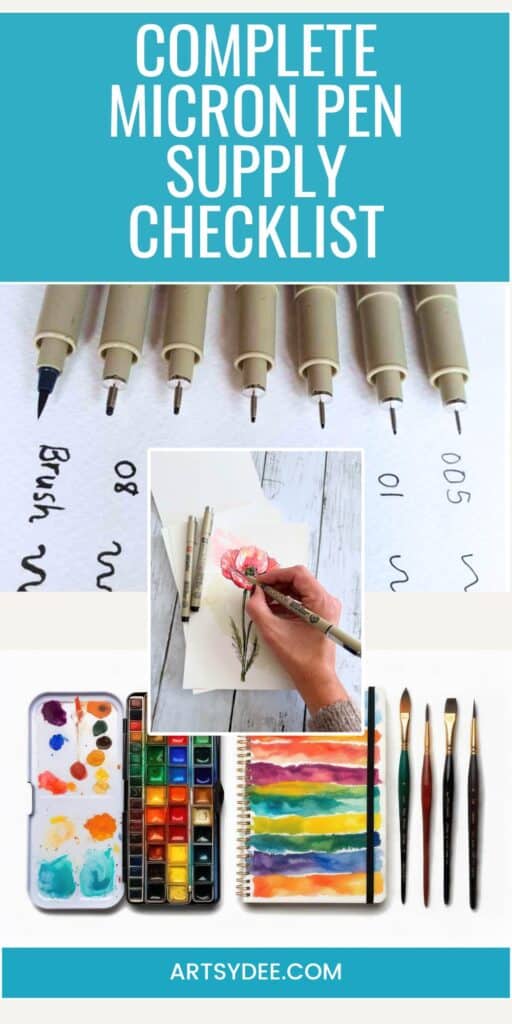
Understanding Micron Pen Sizes: Which One Do You Need?
Micron pens come in a range of nib sizes, each serving a different purpose:

005 (0.20mm) – Ultra-fine. Perfect for intricate details, crosshatching, and delicate line work. The most popular size among illustrators.
01 (0.25mm) – Still very fine but slightly more visible. Great for detailed drawings and fine lettering.
02 (0.30mm) – A versatile middle ground. Works well for general sketching and adding definition.
03 (0.35mm) – Noticeably thicker. Ideal for bolder outlines while maintaining precision.
05 (0.45mm) – Thick enough for emphasis without losing control. Perfect for outlines and adding depth.
08 (0.50mm) – Bold and expressive. Use this for strong outlines, borders, and dramatic contrast.
1.0mm and up – Used primarily by comic artists for heavy blacks and filling large areas.
Brush Tip – A flexible brush-style nib that creates beautiful, flowing lines. Perfect for calligraphy, lettering, and expressive sketches.
My recommendation: Start with a variety pack so you can experiment with different sizes and discover what feels right for your style.
What Can You Create with Micron Pens?

The versatility of Micron pens is unmatched. Here are just a few ways artists use them:
Calligraphy & Hand Lettering
The fine nibs and consistent ink flow make Micron pens perfect for beautiful handwriting and decorative lettering. The brush tip is especially gorgeous for modern calligraphy.
Poetry & Journaling
Writing in small, precise letters with a Micron pen on high-quality paper transforms everyday journaling into an art form. Your words deserve beautiful presentation!
Detailed Sketching
Micron pens excel at capturing fine details—perfect for botanical illustrations, architectural drawings, and realistic portraits.
Pen and Wash
Combine Micron pens with watercolor for stunning mixed-media art. The waterproof ink stays crisp while the paint adds color and atmosphere.
Coloring Books
Intricate coloring pages require fine, controlled lines. Micron pens let you add details and shading that colored pencils alone can’t achieve.
Graphic Design & Illustration
From logos to editorial illustrations, Micron pens create clean, professional line work that scans beautifully.
Contour Drawing
Pure line drawings that define form through outlines and surface planes—Micron pens are made for this.
Manga & Comic Art
Fine details, consistent line weight, and archival quality make these the pen of choice for manga artists and comic illustrators.
Zentangle & Pattern Work
The precision of Micron pens is perfect for repetitive, meditative pattern drawing.

Complete Micron Pen Supply Guide: Everything You Need
Ready to set up your perfect pen and ink workspace? Here’s everything I recommend, from beginner essentials to professional upgrades.
Micron Pen Sets (Your Foundation)
For Beginners: Sakura Pigma Micron 6-Piece Pen Set | Dick Blick This set includes essential nib sizes (005, 01, 02, 03, 05, and 08)—everything you need to explore different line weights and techniques without breaking the bank.
For Expanding Your Range: Sakura Pigma Micron 10-Piece Graphic Pen Set | Dick Blick Includes super-fine 003 and brush tip for maximum versatility. Perfect for artists ready to experiment with more variety.
Add Color to Your Work: Sakura Pigma Micron Colored Fineliners – Pack of 4 Classic black plus bold blue, fiery red, and earthy green. These vibrant, fade-resistant pens add pops of color without sacrificing the precision you love.
Paper for Micron Pens (The Secret to Perfect Lines)
Best All-Around Paper: Strathmore 400 Series Bristol Smooth Paper | Dick Blick Smooth, heavyweight paper that’s perfect for detailed pen work. Doesn’t bleed, feather, or buckle. This is my go-to for ink drawings.
For Pen & Wash: Watercolor Paper 140lb (300gsm) Cold-Pressed Durable with a nice texture that handles both Micron pen work and watercolor washes beautifully.
For Practice & Sketching: Canson XL Series Mixed Media Pad | Dick Blick Affordable, heavyweight paper that works with multiple mediums. Perfect for practicing techniques without worrying about wasting expensive paper.
For Journaling & Line Art: Bianyo Bleedproof Marker Paper Pad Ultra-smooth, acid-free paper that prevents bleed-through. Ideal for markers and fine pens. The 50-sheet pad gives you plenty of room to experiment.
Essential Drawing Tools (Build Your Foundation)
Pencils for Initial Sketching: Prismacolor Turquoise Graphite Pencils. These feel wonderful on paper—smooth, easy to control, and perfect for light sketching before you commit to ink.
Precision Erasing: Prismacolor Kneaded Rubber Eraser Flexible and moldable—shape it to erase tiny details or lift graphite without disturbing surrounding areas.
Blending & Shading: Art Stumps and Tortillons Set | Dick Blick Compressed paper tools for controlled blending, especially useful in smaller areas of your pencil sketches.
Keep Using Every Last Bit: Pencil Extenders. As your pencils get shorter, an extender helps you use them comfortably until the very end—no waste!
Adding Color (Take Your Art Further)

Watercolors: Winsor & Newton Watercolor Set | Dick Blick High-quality paints that work beautifully both underneath and on top of Micron Pen drawing.
Watercolor Brushes: Transon Professional Watercolor Brush Set. A selection of round and flat brushes gives you versatility for different strokes and details.
Mixing Palette: Ceramic Watercolor Palette. Wells for both mixing and holding paints. Ceramic is luxe; plastic works too.
Colored Pencils: Faber-Castell Polychromos. Vibrant, high-quality pigments with smooth application—perfect alongside Micron pen drawing.
Alcohol Markers: Ohuhu Brush Markers Fantastic range of colors, lovely to blend, and work beautifully with Micron Pen sketching.
Special Effects & Finishing Touches
White Gel Pen for Highlights: Sakura Gelly Roll White Pen. Perfect for adding white highlights to your watercolor once it’s dried. Creates stunning sparkle and dimension.
Metallic & Fluorescent Accents: Caran d’Ache Metallic & Fluorescent Pencils Add a touch of shimmer or neon pop to your finished work.
Protect Your Finished Art: Krylon Fixatif Spray | Dick Blick Prevents smudging and preserves your artwork. A must for pieces you plan to display or sell.
Workspace Essentials
Storage & Organization: Art Supply Pencil Case. Keep your pens, pencils, and tools organized and protected. Prevents damage and makes supplies easy to find.
Light Box for Tracing: LED Light Box for Tracing. Transfer sketches cleanly to your final paper. Essential for precision work.
Cutting Mat: Self-Healing Cutting Mat. Protects your work surface and gives you precise cutting guides.
Ruler & Templates: Cork-Backed Metal Ruler. Essential for straight lines and measuring. The cork backing prevents slipping.
Waterproof vs. Water-Soluble: Which Ink Do You Need?
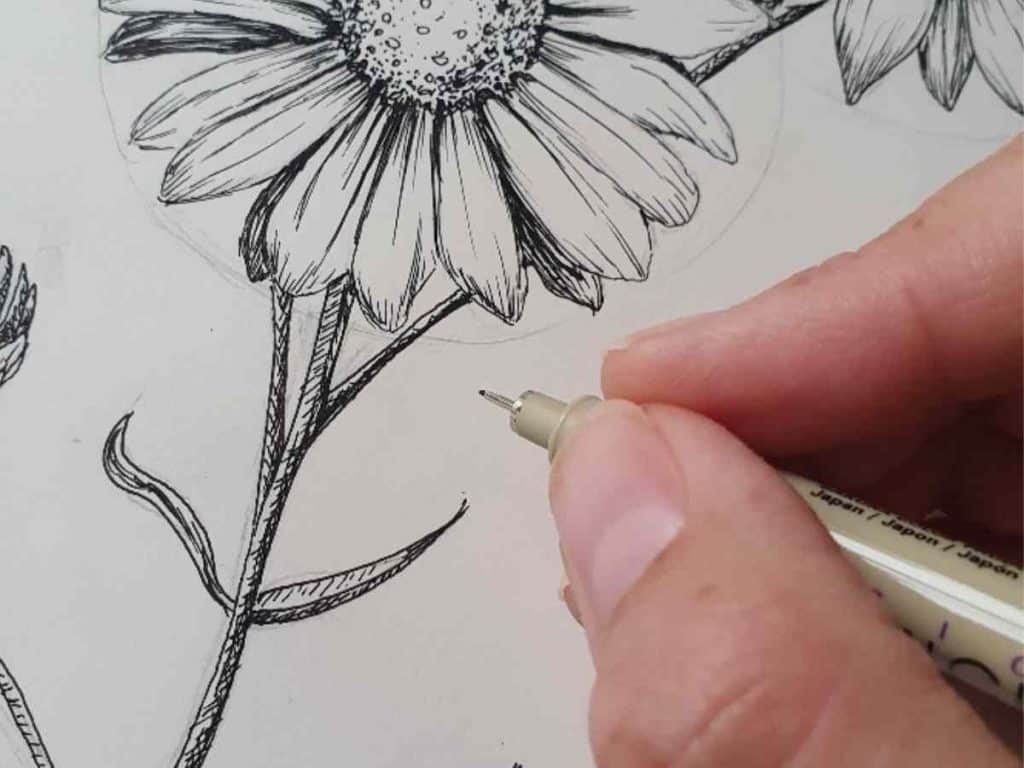
This matters more than you might think!
Waterproof Ink (Micron Standard): Won’t smear when wet. Perfect for mixed media, watercolor painting, and artwork you want to last. Micron pens use archival, waterproof pigment ink.
Water-Soluble Ink: Dissolves when it touches water. Useful for creating wash effects or soft, blended looks.
For most artists: Waterproof is the way to go. It gives you maximum versatility.
How to Store Your Micron Pens (And Make Them Last)
Proper storage can double the lifespan of your pens:
✅ Store in a cool, dry place ✅ Keep them horizontal (not standing upright) ✅ Always replace caps immediately after use ✅ Avoid direct sunlight ✅ Never leave them in a hot car (ink will leak!)
Want to keep them perfectly organized? Check out my post on the Best Pencil Cases for Artists for storage solutions.
Can You Refill Micron Pens?
While Micron pens don’t come with official refills, some artists do refill them using India ink and an eye dropper. Here’s how:
- Use craft pliers to carefully remove the nib
- Fill an eye dropper with waterproof India ink
- Squeeze ink into the barrel
- Replace the nib carefully
Note: This works but voids any warranty and can be messy. Results vary depending on ink consistency.
The History of Sakura Pigma Micron Pens
Sakura Color Products Corporation of Osaka, Japan, has been innovating since 1921. They developed the first oil pastel (Cray-Pas) and revolutionized the pen industry by breaking down pigment particles small enough to pass through ultra-narrow nibs without clogging.
The Pigma Micron pen was originally developed for architects and drafters who needed precision and permanence. Today, artists worldwide rely on them for everything from manga to museum-quality illustrations.
In 1986, Sakura established an American subsidiary, making these incredible pens accessible to artists everywhere.
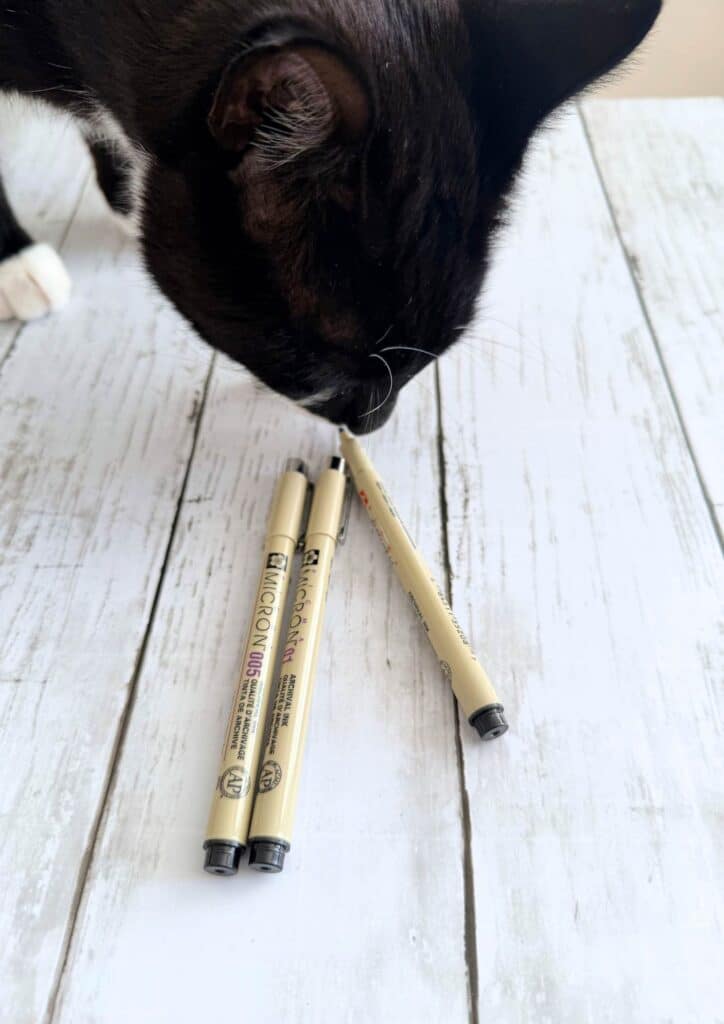
Frequently Asked Questions
Do Micron pens work on glass? No, Micron pens won’t adhere to glass or other non-porous surfaces.
Can I use Micron pens on fabric? Yes! Many quilters use them for quilt labels. The ink is permanent once heat-set. Test on scrap fabric first.
Are Micron pens permanent? Yes, the pigment ink is archival, waterproof, and fade-resistant for up to 100 years.
Why does my pen keep clogging? Usually caused by rough paper, too much pressure, or not shaking the pen before use. Try the scribble technique to get ink flowing again.
Can I use Micron pens for lettering? Absolutely! They’re perfect for hand lettering and calligraphy, especially the brush tip version.
Where to Buy Micron Pens & Supplies
Ready to stock up? Here are the best places to shop:
Online Retailers:
- Amazon – Fast shipping, great for bundles
- Dick Blick Art Materials – Huge selection, artist-grade supplies
Shop Local: Prefer to see supplies in person? Many art stores carry Micron pens and related supplies. Check craft stores like Michaels, Hobby Lobby, or independent art supply shops in your area.
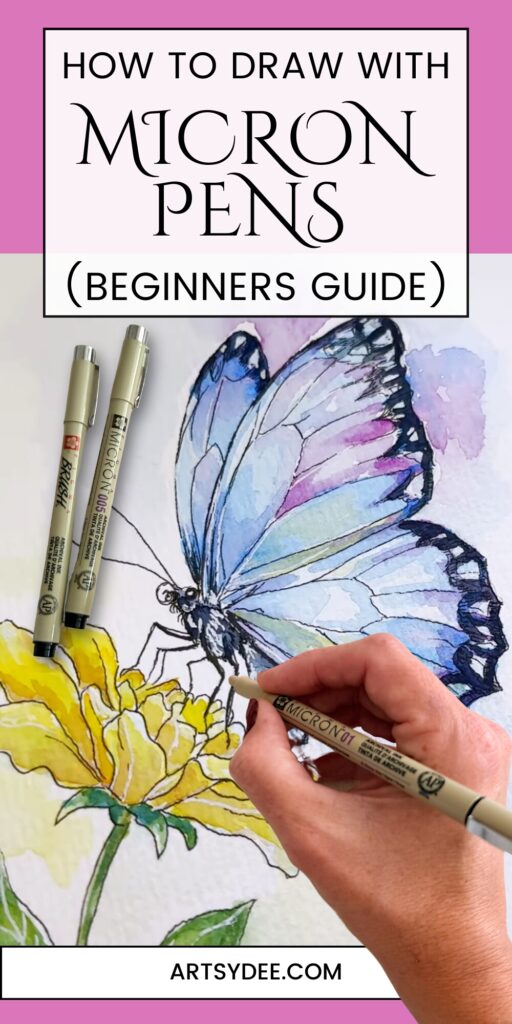
Final Thoughts
Micron pens are an investment in your art practice. With proper technique, the right paper, and quality supplies, you’ll create line work that’s crisp, professional, and built to last.
The most important thing? Practice. Try different nib sizes, experiment with various papers, and don’t be afraid to make mistakes. Every artist who creates stunning pen and ink work started exactly where you are right now.
If you have questions about how to use Micron pens or want to share your own tips and tricks, drop a comment below. I love connecting with fellow artists!
Happy creating!

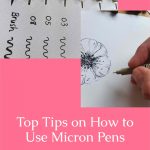






































Has anyone ever reported successfully using micron pens for quilt labels?
I have not personally used them on fabric, however, http://www.theQuiltshow.com says: “Pigma® Micron ink pens are perfect for drawing fine details on your quilt, decorating fabric, making quilt labels, and any application where you need a fine, accurate way to permanently mark on fabric.”
Yes, they can be used on quilts. I made a quilt for my grand-daughter when she was born. She is now 13. The quilt featured blocks of her genealogy on all 4 sides of the family done with a Pigma micron pen.. The quilt has been washed many times over the last 13 years and the lettering is still very legible. My friend also used Pigma pens for her quilt labels with good success.
Thanks so much for this feedback!
That has been my go to for years. Writes great on fabric. I have used it for a signature quilt just ironed freezer paper to the smooth cotton fabric. 🔯
Can these be used to create quilt labels on fabric?
I love 005 but I typically get to use them once before they stop working. I don’t have heavy pressureso I don’t know what Im doing wrong
Yes it’s because its a very tiny nib. Definitely spend some time shaking your pen to get the ink flow into the nib and also scribble on a scrap piece of paper. Store your pen horizontally so that the ink doesnt dry out in the nib. Hope this helps!
One of the things that I love to do with my aging micron pens, specifically 03 and 05 is take an exacto knife and quickly carve a slice from top to end. it turns it into a tiny effective calligraphy pen and I can get a lot more life out of it. Now that I know it can be refilled, this will mean more letters and more life. Micron’s work so well with card stock which I use for card making and art journaling (cut and hole punch) into A5 and A6 notebooks. Micron and Prismacolor pencils + card stock are a great combination.
Hi
I’m new here, and may be one of your older subscriber artists. A little Art Materials History I think I used the *precusor* to the Microns. In the late 1960’s as a mid-teen I was introduced to Rapidiographs (technical pens) of various sizes nibs which produce even, waterproof ink lines. The thinnest are even thinner 005: a 6 x 0!
*Their* removable nibs (by unscrewing) were *quite* the challenge in the smallest 2 sizes because of how the ink flowed through the hollow metal tip attached to the
hollow plastic nib was by an *inner* sort of short rod which at the end held a stiff metal wire. You’d refill the barrel, and also remove the cap on rhe nib to get out the inner rod w wire to clean it, and the inner part of the nib.
Oh, ” the joy” of *very gently* easing the rod/wire back into the outer nib when the wire on the 006 was about as thin as a human hair! You draw w them, but also ere used for graphic design, drawing certain logos for camera ready printing.
.
While I had changed my B&W drawing style, and didn’t use the Rapidiographs any more; you might imagine *how surprised* I was to *find* the Microns, what, maaaybe, *over* 20 years ago. I thought; “wow” a replacement in general for Rapidiographs! SO *less messy!* I did use them at times alone for drawings. I just bought some recently, again, to eventually use them. I have to retry the brush, too.
.
I don’t remember that I had to *shake* them, so Thank You for the reminder! I *never knew* you could remove the nibs to refill the barrel! Thanks! Just regular waterproof black India Ink?
.
Been a long reply, but I’ve been looking off & on to chat about art supplies, and art making.
Welcome! It’s wonderful to have you here, and I absolutely loved reading your insight into Rapidiographs! What a fascinating bit of art materials history—thank you for sharing! I can only imagine the patience and precision needed to clean and reassemble those delicate nibs.
Yes, Microns really were a game-changer in terms of ease of use and mess-free application! I’d love to hear what you think once you revisit them (and the brush pen too!). And yes, you can refill them with regular waterproof India ink—though it can be a bit tricky, and results can vary depending on the ink’s consistency.
I’m so glad you stopped by to chat about art supplies! I always love connecting with other artists, especially those with such a wealth of experience. What kinds of drawings do you enjoy making these days?
Looking forward to hearing more from you!
I bought two Zakira micro perm pens. I used them once then they wouldn’t work. I have tried using alcohol to unstick them. No luck. I was using them over distress oxide. Can you do that? Maybe I didn’t let it dry long enough and it plugged it up. But I’ve got 5 pounds including micron. I’m having nothing but issues with them. Not sure what I’m doing wrong.
Hi there,
Thanks so much for sharing this—it sounds really frustrating, and I completely understand how disheartening that can be when you’re excited to create.
Micron and Micro Perm pens can be a bit temperamental, especially over surfaces like Distress Oxide, which stays reactive and can be a bit chalky. If the ink wasn’t fully dry or if there was any moisture still on the surface, it might have clogged the pen tip. Unfortunately, once those tips get gummed up, they’re tricky to revive.
You’re definitely not doing anything wrong—these pens just have very specific surfaces they like! If you’re working over mixed media or Distress backgrounds, I’d recommend doing your penwork either before adding those layers or trying a paint pen or archival ink pen made for non-porous or textured surfaces.
Don’t give up—sometimes it’s just about finding the right combo that plays nicely together. Feel free to message me if you want help testing alternatives. I’d love to help!
Warmly,
Dee
I needed see a label for quilts. I printed directly on material if set correctly.
Hi there,
Thanks for your comment! I’m not totally sure I understand—are you saying you printed your quilt label directly onto fabric using your printer? That sounds really interesting! I’d love to hear more about your process if you’re open to sharing—especially how it connects with Micron pens or if you found another method that worked well.
Appreciate you stopping by the blog!
Warmly,
Dee
I NEVER KNEW YOU WERE SUPPOSED TO SHAKE THEM EITHER.
ALL YOUTUBE TUTORIALS NEVER MENTIONED THAT. I HAVE BEEN DRAWING WITH MICRON PENS FOR A COUPLE YEARS.
I AM 85 YEARS OLD.
Hi there,
Thank you so much for your message—it made me smile! 😊 I’m so glad I could share a little tip that was helpful. Isn’t it funny how even after years of using something, there’s always something new to learn?
I’m truly inspired that you’ve been creating art with Micron pens for years—and at 85, that’s incredible! Your creativity and curiosity are such a gift. Please keep drawing and exploring—it’s never too late to discover something new (or shake a pen! 😉).
Wishing you many more joyful hours of creating!
Warmly,
Dee
Where can I find replacement nibs for Micron pens?
Hi Diane! 😊 Great question — Micron pens are technically considered disposable because Sakura (the brand that makes them) doesn’t offer official replacement nibs or refills. That said, some artists do carefully replace damaged nibs using spare ones from old pens of the same size (like swapping the nib from a dried-out 01 into one that still has ink). It’s a bit of a DIY trick and not officially supported, so it’s best done gently with tweezers and only if you’re comfortable.
If you’re looking for something longer-lasting, you might like Copic Multiliner SP pens — they’re refillable and have replaceable nibs. Or you could stock up on Micron multi-packs so you always have backups ready ✨
Hope that helps and happy creating!
– Dee 🎨
Really great information! Thanks
I can’t get the link for the practice sheets to work. How do I get them?
Hi Diane, Right at the end of the blog post you will see a locked box – the worksheets are the excluisve content behind the lock. You login using the Grow credentials you signed up with! Then simply download the PDF. x